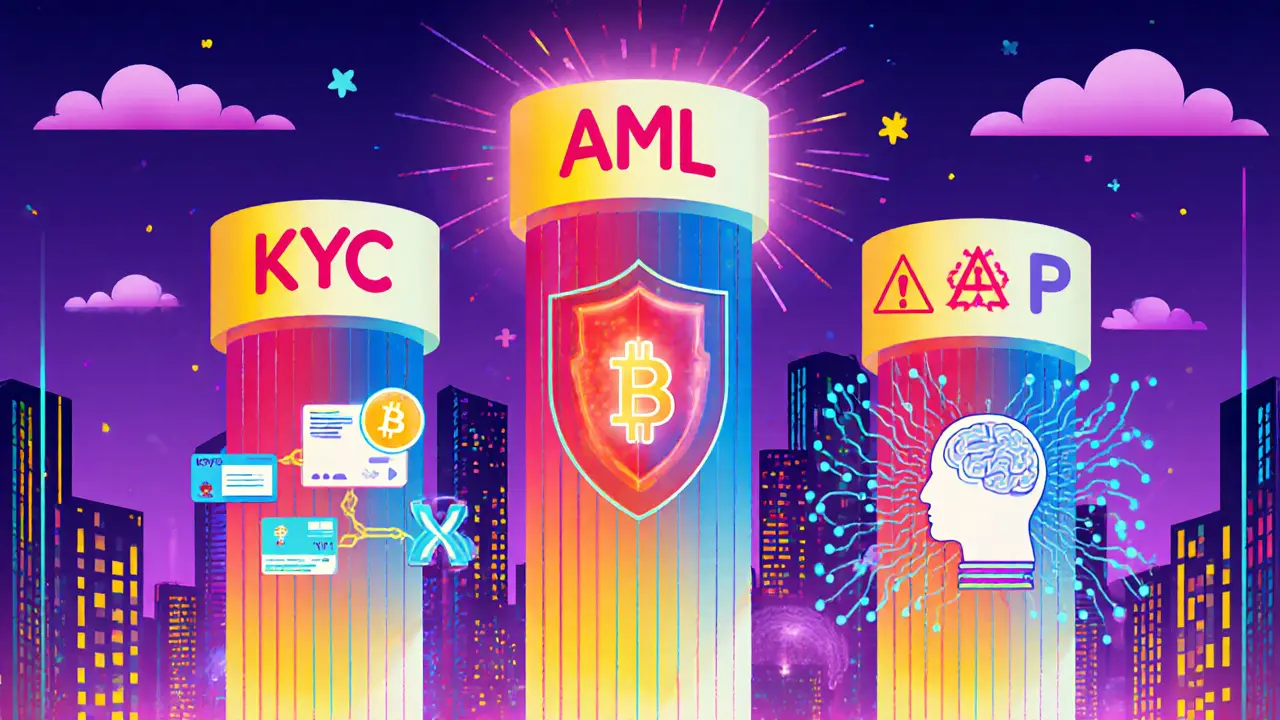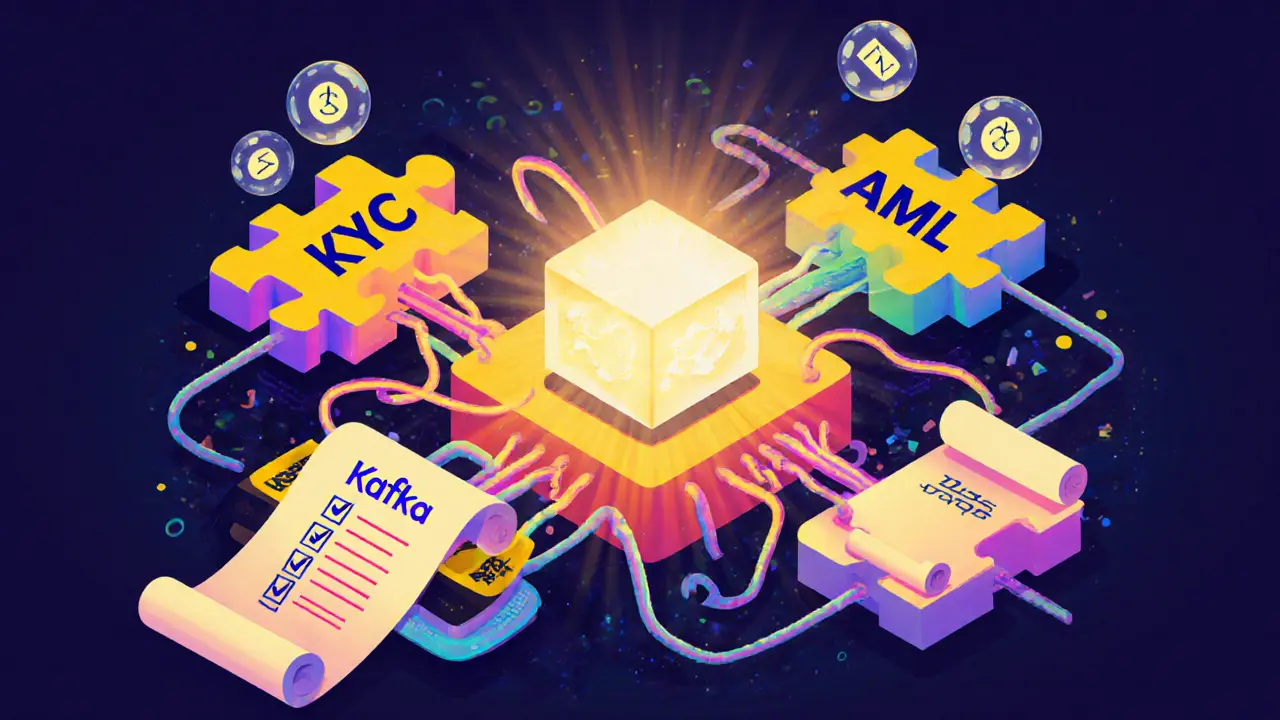Compliance Cost Calculator
Estimate Your Compliance Costs
Calculate your estimated implementation and annual operating costs for a crypto compliance program based on your business size, jurisdiction, and required features.
Estimated Annual Costs
Based on industry data from StarCompliance and Blockchain App Factory (2025)
* Implementation cost includes software licenses, API usage, and consulting fees
* Annual cost includes staff salaries, audit fees, and data storage
Key Takeaways
- Regulatory frameworks in the US, EU and UAE now demand full‑stack compliance programs for any crypto business.
- Three pillars - KYC, AML/PEP screening, and real‑time transaction monitoring - form the backbone of any effective program.
- Implementation costs range from $50,000 for a basic solution to over $1 million for enterprise‑grade platforms.
- Modular architecture and AI‑powered analytics cut false positives and make future regulatory updates easier.
- A compliance checklist at the end of this guide helps you verify you’ve covered the essentials before launch.
What Is a Crypto Compliance Program?
A structured framework that enables cryptocurrency businesses to meet global anti‑money‑laundering (AML), counter‑terrorist financing (CTF), and data‑privacy rules while maintaining operational efficiency. The concept grew from the 2013 FinCEN guidance that classified crypto exchangers as Money Services Businesses (MSBs) under the US Bank Secrecy Act. By 2025 the term has expanded to cover everything from identity verification to blockchain‑specific transaction analytics.
Who Needs to Comply? The Role of a Virtual Asset Service Provider (VASP)
Any entity that offers custody, exchange, transfer, or trading services for digital assets. Whether you run a centralized exchange, a custodial wallet, or a DeFi aggregator, you are a VASP and must embed a compliance program into your core processes.
Regulatory Landscape in 2025
The world’s biggest markets have converged around three major regimes: the United States, the European Union, and the United Arab Emirates. Each has its own licensing, capital, and record‑keeping rules.
United States
The US still uses a fragmented approach.
FinCEN
Financial Crimes Enforcement Network, the primary US AML regulator. demands VASPs follow the Crypto Travel Rule for transfers above $3,000, sharing sender and receiver details with counterpart VASPs. In addition, the SEC, CFTC, state money‑transmitter offices, and NYDFS may require separate licenses - sometimes up to 47 state permits for a nationwide operation.
European Union - MiCA
The EU’s Markets in Crypto‑Assets (MiCA)
A unified regulatory framework for crypto service providers across all 27 EU member states.
United Arab Emirates
The UAE runs two parallel regimes: Dubai’s VARA and the ADGM/DIFC framework. VARA requires a three‑tier KYC process and a 5‑year data‑retention policy, while ADGM/DIFC pushes for 8‑year retention and real‑time analytics. Licensing timelines are far quicker - typically 90 days versus 180 + days in the US.

Core Pillars of a Modern Program
2025 compliance models revolve around three interconnected pillars.
1. Identity Verification (KYC)
Know Your Customer (KYC)
The process of confirming the true identity of a user before allowing certain transactions. Tiered verification is the norm: email confirmation for < $1,000, photo‑ID for $1,000‑$3,000, and Enhanced Due Diligence (EDD) for anything above $3,000, often requiring proof‑of‑wealth documents.
2. AML / PEP Screening
Anti‑Money Laundering (AML)
A set of procedures designed to detect and prevent money‑laundering activities. Combined with Politically Exposed Persons (PEP) checks, this pillar flags sanctioned individuals and high‑risk entities before they can transact.
3. Wallet & Transaction Monitoring
AI‑driven analytics now scan 10,000+ transactions per second with around 98.7 % accuracy in flagging suspicious activity, according to the 2025 Blockchain App Factory checklist. Real‑time alerts, pattern‑recognition, and blockchain‑explorer integration are must‑have features.
Technology Stack and Vendors
Building a compliant stack means stitching together identity providers, monitoring engines, and secure data stores.
- Identity Verification: Sumsub, Onfido, Veriff - all offer API‑first SDKs that plug into onboarding flows.
- Transaction Monitoring: Chainalysis KYT, CipherTrace, Elliptic - leverage graph analytics and machine learning.
- Data Retention & Security: AWS GovCloud, Azure Confidential Compute, or on‑premise encrypted SQL clusters that satisfy 5‑year (Dubai) or 8‑year (ADGM) storage mandates.
When comparing solutions, price ranges vary dramatically. StarCompliance
Industry benchmark provider that tracks pricing and implementation metrics. reports annual fees from $50,000 for a midsize exchange to over $1 million for enterprise platforms.
Cost, Timeline, and Resource Planning
Expect a 6‑9 month rollout for a mid‑size exchange; larger platforms often need 12‑18 months. Budget for three cost buckets:
- Software licences and API usage: $30‑$200 k per year depending on volume.
- Consulting & legal fees: $150‑$400 k for initial licensing (MiCA, VARA, US state permits).
- Ongoing operational costs: staff salaries, audit fees, and data‑storage expenses - typically 15‑20 % of total budget.
Only about 12 % of traditional compliance professionals have the blockchain expertise needed, so hiring or up‑skilling staff is a critical path.
Building a Modular, Future‑Proof Architecture
Regulations evolve fast. A modular design lets you swap out a KYC provider or add a new monitoring rule without a full system rewrite.
- Micro‑services layer: Separate KYC, AML, and monitoring into independent services accessed via an API gateway.
- Event‑driven pipelines: Use Kafka or Pub/Sub to stream blockchain transaction data to analytics engines in real time.
- Privacy‑enhancing tech: Zero‑knowledge proofs can prove a user meets age or residency criteria without revealing the underlying data.

Comparison of Jurisdictional Requirements
| Requirement | United States | EU (MiCA) | UAE (VARA) |
|---|---|---|---|
| License type | Multiple state money‑transmitter licenses (up to 47) + FinCEN registration | Single pan‑EU VASP licence | VARA licence (Dubai) or ADGM/DIFC licence |
| Capital minimum | Varies by state (often $100k‑$250k) | €125,000 | Dirham 500,000 (approx. $136k) | TRM Labs, 2025
| Record‑keeping period | 5 years (FinCEN) | 5 years (MiCA) | 5 years (VARA) / 8 years (ADGM) |
| Travel Rule threshold | $3,000 (FinCEN 2025 update) | $3,000 (MiCA aligns with FATF) | $3,000 (UAE adopts FATF) |
| Typical licensing timeline | 180‑365 days | 90‑120 days | ~90 days |
Common Pitfalls and Pro Tips
Pitfall 1 - Over‑engineering KYC. Requiring full ID for tiny trades can shave off 30 % of sign‑ups. Use tiered verification to keep friction low.
Pitfall 2 - Treating blockchain analytics as an afterthought. Integrate chain‑analysis APIs at the onboarding stage; retro‑fitting later creates data gaps.
Pro Tip - Leverage compliance consultants early. 73 % of successful implementations cite third‑party guidance as a decisive factor.
Pro Tip - Automate audit trails. Store every API call, user consent, and AML alert in an immutable log. Auditors love it; regulators require it.
Next‑Step Checklist
- Map the jurisdictions you’ll serve (US, EU, UAE, etc.).
- Choose a VASP licence path and start the application early.
- Select KYC and AML providers that support tiered verification and real‑time APIs.
- Architect a micro‑services stack with event‑driven transaction feeds.
- Implement data‑retention policies that meet the longest required period (8 years for ADGM).
- Run internal red‑team simulations to test false‑positive rates and user‑experience impact.
- Schedule a third‑party compliance audit before going live.
Frequently Asked Questions
Do I need a compliance program if I only operate in one country?
Yes. Even a single‑country operation must meet that nation’s AML/KYC rules. In the US you’ll still need FinCEN registration and possibly a state money‑transmitter licence.
How much does a full‑stack compliance solution cost?
For a midsize exchange, annual spend ranges from $50,000 to $500,000, covering software licences, consulting, and ongoing monitoring. Enterprise‑grade platforms can exceed $1 million per year.
What is the Crypto Travel Rule and why does it matter?
The Travel Rule, adopted by FinCEN in 2025, forces VASPs to share sender and receiver details for transactions above $3,000. Failure can trigger fines, license suspension, and loss of banking relationships.
Can I use the same compliance stack for both crypto and fiat services?
Generally yes, but you’ll need to add blockchain‑specific analytics and meet the stricter record‑keeping periods of crypto regulators. A modular architecture makes this switch easier.
How do I balance privacy with KYC requirements?
Use zero‑knowledge proofs or hashed identifiers to prove compliance without exposing raw personal data. Store full documents in encrypted vaults with strict access controls.

Write a comment